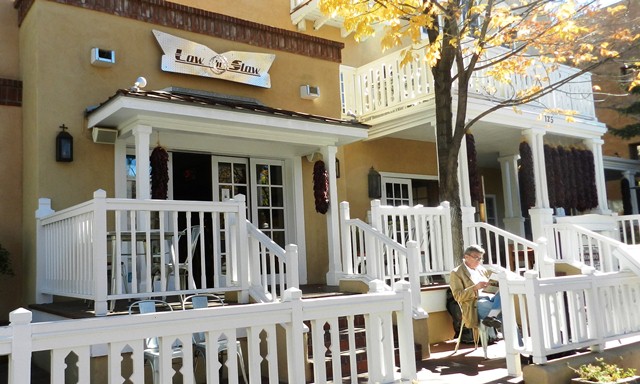» posted on Tuesday, October 30th, 2012 by Linda Lou Burton
They Get It
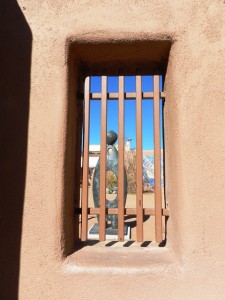 Linda Burton posting from Santa Fe, New Mexico – “There is no other place in the country where cultures meet, and blend, like they do here.” So said Maria, explaining to me why she loves Santa Fe so much. My first question to her was “Why are all the buildings brown?” She answered that the southwest adobe style was the heritage of centuries past. Maria, a Greek transplant from Chicago, laughed as she pointed out her dark hair and skin tones. “People think I’m Spanish,” she continued, “and because I speak Spanish fluently, I fit in here from the first day. I get what this city is all about. Some people don’t. I can see it on their face; they seem puzzled by what they interpret as ‘sameness.’ To me, it is a love and respect for the land, and for the traditions of the past. As a child I visited my grandparent’s farm in Greece; they lived simply and wasted nothing. They used what they had, and that’s what Native Americans did here centuries ago. They had sand and clay and water and straw; that’s what they used to make their houses. Their houses were earth-toned because they were made of earth! That tradition is held today in Santa Fe. And besides, it’s the law.” The law? After my conversation with Maria, I did some research into the city’s history. I found The Ordinance of 1957, and I learned about John Gaw Meem.
Linda Burton posting from Santa Fe, New Mexico – “There is no other place in the country where cultures meet, and blend, like they do here.” So said Maria, explaining to me why she loves Santa Fe so much. My first question to her was “Why are all the buildings brown?” She answered that the southwest adobe style was the heritage of centuries past. Maria, a Greek transplant from Chicago, laughed as she pointed out her dark hair and skin tones. “People think I’m Spanish,” she continued, “and because I speak Spanish fluently, I fit in here from the first day. I get what this city is all about. Some people don’t. I can see it on their face; they seem puzzled by what they interpret as ‘sameness.’ To me, it is a love and respect for the land, and for the traditions of the past. As a child I visited my grandparent’s farm in Greece; they lived simply and wasted nothing. They used what they had, and that’s what Native Americans did here centuries ago. They had sand and clay and water and straw; that’s what they used to make their houses. Their houses were earth-toned because they were made of earth! That tradition is held today in Santa Fe. And besides, it’s the law.” The law? After my conversation with Maria, I did some research into the city’s history. I found The Ordinance of 1957, and I learned about John Gaw Meem.
 John Gaw Meem IV (1894-1983) was born to Episcopalian missionary parents in Brazil; schooled in Virginia; and came to New Mexico for his health in 1920. An American architect whose influence on the city of Santa Fe continues today, he headed the committee that authored the 1957 Historic Styles Zoning Ordinance, a law that ensured that all future buildings in central Santa Fe would continue the style of the “old quarter.” The ordinance draws a line around “historic downtown” and dictates that all buildings within this 300-acre area adhere to design guidelines that are spelled out in detail. This ordinance not only affected the city of Santa Fe, it led the way toward sensitive preservation of historic districts throughout the United States. And, the strict adherence to “tradition” drew criticism, as well.
John Gaw Meem IV (1894-1983) was born to Episcopalian missionary parents in Brazil; schooled in Virginia; and came to New Mexico for his health in 1920. An American architect whose influence on the city of Santa Fe continues today, he headed the committee that authored the 1957 Historic Styles Zoning Ordinance, a law that ensured that all future buildings in central Santa Fe would continue the style of the “old quarter.” The ordinance draws a line around “historic downtown” and dictates that all buildings within this 300-acre area adhere to design guidelines that are spelled out in detail. This ordinance not only affected the city of Santa Fe, it led the way toward sensitive preservation of historic districts throughout the United States. And, the strict adherence to “tradition” drew criticism, as well.
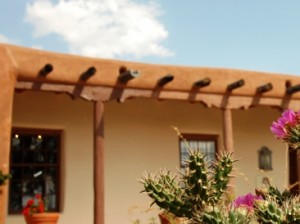 Meem designed a number of important buildings in Santa Fe; also on the University of New Mexico Campus and throughout New Mexico; many of his works are listed on the National Register of Historic Places. He was an advocate for “architecture of place” and saw his work as a new way of using age-old building methods in a hot, arid climate. “If it’s functional, it’s modern,” he said.
Meem designed a number of important buildings in Santa Fe; also on the University of New Mexico Campus and throughout New Mexico; many of his works are listed on the National Register of Historic Places. He was an advocate for “architecture of place” and saw his work as a new way of using age-old building methods in a hot, arid climate. “If it’s functional, it’s modern,” he said.
Another name that popped up in my research was that of Carlos Vierra (1876-1937), an artist of Portuguese descent. He and Meem met when both were recovering from tuberculosis at  Sunmount Sanatorium; they influenced each other with regard to Santa Fe “style” and its preservation. Vierra too was an advocate for preserving landmark buildings; he had an influential role in restoring the Palace of the Governors, the oldest capitol building in the United States (1610). But the home he built on Old Santa Fe Trail is considered to be “the first residence built in Pueblo Revival Style,” I read.
Sunmount Sanatorium; they influenced each other with regard to Santa Fe “style” and its preservation. Vierra too was an advocate for preserving landmark buildings; he had an influential role in restoring the Palace of the Governors, the oldest capitol building in the United States (1610). But the home he built on Old Santa Fe Trail is considered to be “the first residence built in Pueblo Revival Style,” I read.
Santa Fe Style; Pueblo Revival Style; Territorial Style; how are these defined? That’s my next question. These are still vague terms to me; what do they really mean? What do they look like? What exactly is “a blending of cultures”? Which cultures?
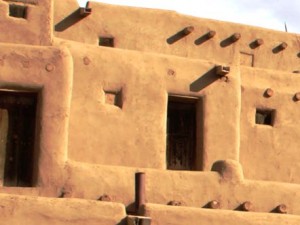 Go back more than a thousand years. Native Americans in the area were building communal dwelling places out of mud, strengthened by the addition of rocks, sticks and straw (what we now call adobe). The basic structure was earthen walls supporting a flat roof; no doors on the bottom floor; ladders through openings to the living quarters above. Many of these substantial buildings and ancient villages still stand. There are 21 federally recognized “pueblos” in the United States today; 19 of them in New Mexico. Often they were built to great size; you can visit the beautiful multistoried Taos Pueblo today; it’s a UNESCO World Heritage Site as well as a National Historic Place . http://www.taospueblo.com/
Go back more than a thousand years. Native Americans in the area were building communal dwelling places out of mud, strengthened by the addition of rocks, sticks and straw (what we now call adobe). The basic structure was earthen walls supporting a flat roof; no doors on the bottom floor; ladders through openings to the living quarters above. Many of these substantial buildings and ancient villages still stand. There are 21 federally recognized “pueblos” in the United States today; 19 of them in New Mexico. Often they were built to great size; you can visit the beautiful multistoried Taos Pueblo today; it’s a UNESCO World Heritage Site as well as a National Historic Place . http://www.taospueblo.com/
Along came the Spanish in the 1500’s, who gave the name “pueblo” to the buildings they saw; it is derived from the Latin word “populous” meaning “people.” They modified the design process by forming the mud into bricks for more rapid construction; with their metal tools they easily cut wood and added wooden doors and portales (porches) supported by zapatas (posts).
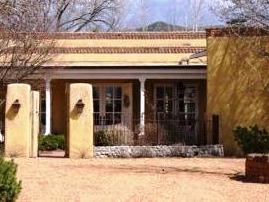 In the 1800’s the railroads brought another major change. They brought new building materials, such as metal for roofs and glass for windows; they also brought better tools. The first sawmills were built, reforming local building technology by processing posts and beams. And they brought a new fashion – Greek Revival style. As it was adapted to the frontier economy, and the adobe construction, it became known as Territorial style.
In the 1800’s the railroads brought another major change. They brought new building materials, such as metal for roofs and glass for windows; they also brought better tools. The first sawmills were built, reforming local building technology by processing posts and beams. And they brought a new fashion – Greek Revival style. As it was adapted to the frontier economy, and the adobe construction, it became known as Territorial style.
Pueblo Deco? Go to the 1920’s and the art deco movement. Blend cubist forms with geometric decorations; mix it up; the La Fonda Hotel in Santa Fe follows this style. Pueblo  Revival? John Gaw Meem’s influence leads the committee that creates that 1957 ordinance and, some say, stops the evolution of style right then and there.
Revival? John Gaw Meem’s influence leads the committee that creates that 1957 ordinance and, some say, stops the evolution of style right then and there.
You notice the Santa Fe Theme right away; low profile buildings with thick brown stuccoed walls and rounded edges; the windows are small. Critics have commented – “reminds me of the Stone Age cartoon buildings in Bedrock,” or “the buildings look like they’ve been rolled in brown sugar.” Some who have come have left in frustration over building codes; I read a newspaper account of TV star Larry Hagman who in 1995 requested permission to add a second story to his house; his request was denied; he did not chose to stay in Santa Fe.
 And then there are those like Maria, who are drawn to the city because it does preserve the past in a charming blend of Native American, Spanish, and Anglo memories. Yet modern techniques are creeping in; adobe once might have been the “poor man’s” building material but now costs considerably more than wood and other materials; experienced adobe craftsmen are rare. Stay in compliance with the ordinance by using “Rastra” (blocks of concrete and recycled Styrofoam); with the help of chicken wire, brown stucco can be applied over that. The requirement for small window panes? Add adhesive tape inside large picture windows. But even without government regulation, much of the rest of town is influenced by the Santa Fe style, sometimes through private covenants, personal taste or market forces.
And then there are those like Maria, who are drawn to the city because it does preserve the past in a charming blend of Native American, Spanish, and Anglo memories. Yet modern techniques are creeping in; adobe once might have been the “poor man’s” building material but now costs considerably more than wood and other materials; experienced adobe craftsmen are rare. Stay in compliance with the ordinance by using “Rastra” (blocks of concrete and recycled Styrofoam); with the help of chicken wire, brown stucco can be applied over that. The requirement for small window panes? Add adhesive tape inside large picture windows. But even without government regulation, much of the rest of town is influenced by the Santa Fe style, sometimes through private covenants, personal taste or market forces.
It appears to me that regardless of any bickering or changes in lifestyles and tastes, people continue to flock to Santa Fe for all of the things that make it a beautiful place to live. Like Maria, they “get it.”
About City of Santa Fe http://www.santafenm.gov/
A to Z New Mexico architectural and decorating terms
- Adobe – a building material traditionally made of mud and straw, modern practice is to use sand and clay
- Bancos – low (earthen) benches, built into the walls for seating
- Banos – bathrooms
- Canale – water spout or roof drain
- Cocina – kitchen
- Comedore – dining room
- Entrada – entryway
- Fogon – a corner set fireplace
- Hacienda – territorial mansion
- Horno – round earthen wood oven, usually outdoors
- Jardines – garden
- Kiva – used to connote shape such as a round front fireplace
- Latillas – small saplings, usually used for form a ceiling, often placed on vigas
- Olla – basket
- Maceta – flower pots, also an enclosed patio in a hacienda, bright place
- Miridor – balcony
- Nicho – a niche for a statue
- Parapets – wall section above the roof line
- Placitas – small plazas
- Portales – porches, covered and supported by zapatas
- Ramada – free standing canopy
- Retablo – painted wood plaque, usually a saint
- Ristra – string of red chile
- Sala – living room, must have a fireplace
- Saltillo – clay or terra cotta tile, traditionally cured in the sun, now often fired
- Santos – wood carved statue of a saint
- Stucco – plaster or mud finish, now usually a cement product or may have an elastomeric color coat
- Viga – round wooden beam, ceiling support
- Zapatas – corbelled imposts

